Potatoes are the go-to vegetable for home gardening. Homegrown potatoes taste much better than store-bought ones, they are easy to grow, and harvesting them is especially exciting—it's like digging for treasure!
Another reason to grow your own potatoes? Variety. Potatoes are cultivated and consumed worldwide, with over 5,000 varieties currently known, and the list keeps growing. While the best gourmet grocery stores offer only a few choices, you can grow anything you can find. Potatoes come in a rainbow of colors, including white, yellow, blue, purple, pink, or red.
The Origin of Potatoes
Although potatoes (Solanum tuberosum) are commonly referred to as "Irish" potatoes, distinguishing them from sweet potatoes (Ipomoea batatas) or yams (Dioscorea), which are entirely different plant species, these delicious tubers actually originated in the Andes Mountains of South America, not in Ireland (or Idaho). Potatoes belong to the nightshade family, which also includes tomatoes, peppers, and eggplants.
Potatoes were brought to Europe by Spanish conquistadors in the early 1500s, shortly thereafter introduced to England and Ireland, and then crossed the Atlantic again in the early 1700s to reach North America. Though potatoes are now popular—Americans, for example, consume an estimated one per person per day—they were a hard sell for many when first introduced to Europe.
Planting Potatoes
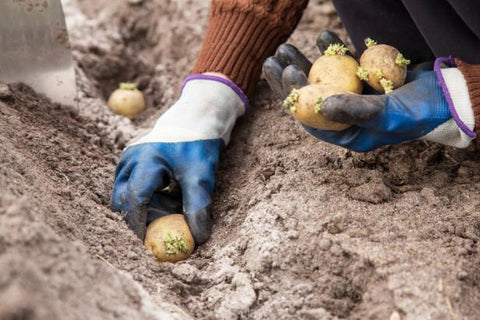
Potatoes can be planted in spring in all regions, with a second planting in the fall in mild climates, from small mature tubers called "seed" potatoes, each with one or two sprouts. Purchase certified seed potatoes from reputable sources; many online seed companies also sell them.
Plant immediately after digging soil in early spring; plan ahead if the weather is typically rainy at that time, planting on mounds or hills in the fall. In frost-free regions of the country, including the Southwest and along the Gulf Coast, potatoes can be planted in the fall or winter; however, seed potatoes are often hard to find, so ordering and storing them in advance is necessary.
Can You Plant Grocery Store Potatoes?
While you can try planting grocery store potatoes, these commercial potatoes may have been sprayed with chemicals to prevent sprouting during storage, which can hinder growth and result in reduced or disappointing yields. Trust us: it's best to use seed potatoes.
When to Plant Potatoes
Potatoes thrive in cool weather—neither freezing nor hot. Though healthy potato plants can withstand light frosts and even recover from minor frost damage, they cannot survive severe cold. Plant potatoes a few weeks before the last frost date, but before the arrival of hot summer weather.
How to Plant Potatoes
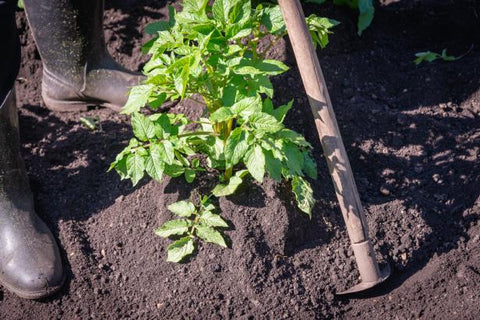
Cut seed potatoes into pieces two to three days in advance, allowing cut surfaces to heal to reduce rotting when planted in cold, wet soil. These pieces can also sprout or "chit" in the weeks before planting, which can be helpful in colder and short growing season areas.
Plant potatoes, eyes (sprouts) up, two to three inches deep, spaced about a foot apart.
For traditional hill planting, keep rows three to four feet apart.
Dig planting furrows six inches deep, piling excess soil from furrows alongside for hilling.
On beds using intensive planting methods like raised wooden beds, space potatoes 12 inches apart, planting in staggered rows.
In containers, you can plant potatoes more densely, with smaller yields.
Tips for Planting Potatoes
In addition to cool weather, potatoes need at least six hours of sunlight, well-drained soil, regular watering, and moderate fertilization. For clay soils, add compost to improve drainage and prevent waterlogged soil from rotting potatoes.
Tuber formation is heaviest when soil temperatures are in the 60-70-degree range, stopping when soil temperatures reach around 80 degrees.
Covering the soil with straw or other organic material can help reduce soil temperature by up to 10 degrees.
If growing in containers, water more frequently as they tend to dry out faster.
Hilling Potatoes
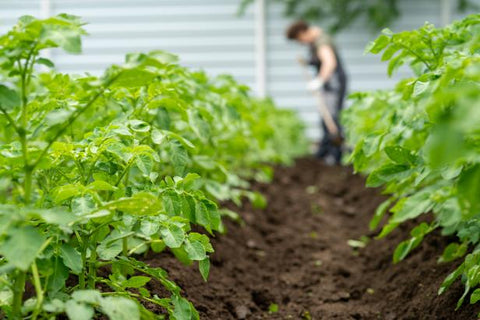
After planting seed potatoes, they quickly sprout, growing into lush, multi-stemmed plants. As the plants grow, new tubers begin forming on short stolons growing downward into the soil. Since exposed potatoes turn green, making them taste bitter, it's essential to mound soil or thickly mulch or cover the lower stems of the plants, allowing tubers to grow in complete darkness. This is called "hilling" potatoes.
Start hilling potatoes when the stems reach six to eight inches high. Hill potatoes every two weeks, continuing until plants have at least six inches of stems buried.
Collect soil around the stems, covering about 1/2 to 2/3 of exposed stems and leaves. Most gardeners make one or two hills, but you can continue hilling throughout the growing season.
To have enough soil for hilling, remove the top 12 inches of soil before planting and store it nearby. You can also use a mix of homemade compost and bagged potting mix or topsoil for hilling. Or save soil from container gardens at the end of the growing season for this purpose, mixed with compost.
Using straw instead of soil simplifies the hilling process. Add straws regularly to maintain a constant level. With this method, harvesting becomes effortless—no digging required. Just pull aside the straw to reveal the tubers.
Whether using soil or straw, keeping potato roots moist is crucial about two weeks before harvest. Potato roots are shallow and sensitive to fluctuations in soil moisture.
When using soil for hilling, it's best to add a covering layer. Coverings reduce evaporation and maintain lower soil temperatures.
When to Harvest Potatoes
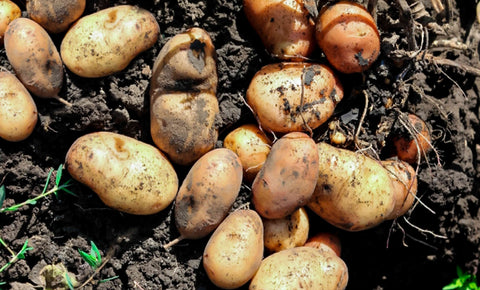
Depending on the variety and local weather, potatoes take about three to four months from planting to digging, with early maturing varieties or immature or "new" potatoes ready a bit earlier. Most gardeners plant in March, April, or May, expecting to harvest about four months later, beginning to dig new potatoes about two to three weeks after plants flower.
Harvest "new" potatoes—any small potatoes harvested before all sugar converts to starch—several months after planting, by pulling up a plant or two, or feeling around in the soil or straw and pulling out some young potatoes.
When the tops of plants start to die back, you'll know it's time for the main harvest. Or calculate the number of days your variety needs to mature after planting and harvest accordingly. Let the soil dry a bit before harvesting to prevent clumping on tubers.
Do not wash newly dug potatoes. Instead, give them a gentle brush with gloved hands.
Freshly harvested potatoes need time to cure and form a dry skin before storage. Cure potatoes by spreading them in a single layer in a shaded area at room temperature for about two weeks.
Once cured, expect potatoes to store for several months or longer in a cool, dark place.
Types of Potatoes

While the basic growing method is the same for all true potatoes, there are differences in plant productivity and disease resistance as well as in the shape, size, color, and cooking quality of tubers.
Potatoes come in six basic types, each with many varieties. Each type has certain characteristics that make them suitable for different cooking methods. They are classified into six types based on starch content: starchy, waxy, and all-purpose or medium. Starchy potatoes are more floury or mealy and are better for baking, mashing, and making fries or chips. Waxy potatoes have lower starch content, are firmer, and are better for soups, potato salads, and stews or casseroles. All-purpose potatoes fall between the two.
Russet (starchy)
Yukon Gold (all-purpose)
Red (waxy)
White (waxy)
Blue (all-purpose)
Fingerlings (waxy)
Within these types, there are countless heirloom varieties available for home planting. Here's more information on each type and favorite planting varieties.
Russet

Russets are classic "Idaho" potatoes, with thick skins, commonly used for baking, frying, and mashing. Russets have low moisture content and often come out a bit dry when cooked, so most chefs add milk or butter when mashing.
Yukon Gold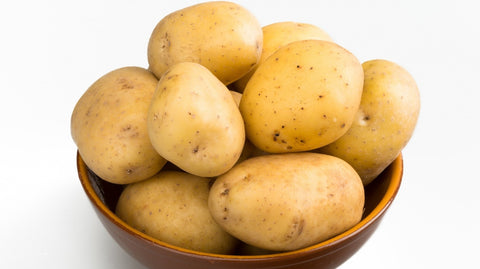
Yukon Golds are versatile potatoes, great for mashing, steaming, boiling, baking, roasting, and frying.
Red

Red potatoes are sturdy and excellent for making potato salads and soups, as well as for steaming, boiling, roasting, making au gratin dishes or scalloped potatoes, and salads.
White
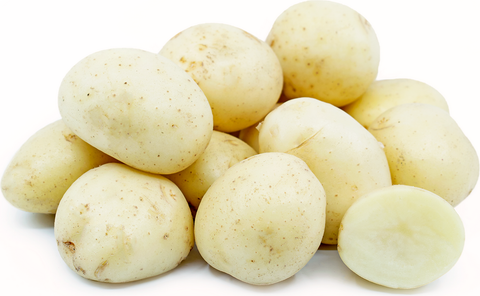
White potatoes have low starch content and are excellent for boiling, potato salads, mashing, steaming, roasting, and baking.
Blue

Blue potatoes, also known as purple potatoes, turn purple when cooked because of their high antioxidants, have moderate starch content, and are excellent for steaming, baking, and boiling.
Fingerlings

"Fingerling potatoes" are typically finger-sized and shaped. Due to their small size and sometimes differing skin and flesh colors, they are excellent as side dishes. Most have a mild, somewhat nutty flavor, best enjoyed roasted or baked, or even boiled—but they tend to fall apart in soups.
Varieties Classified by Harvest Time
Potato varieties can also be classified based on the time they take from planting to harvest.
Early season varieties are planted first in spring and harvested in 60-80 days. They can only be stored for a few weeks.
Mid-season varieties mature in 80-100 days. They typically store for about a month.
Late season potato varieties are ready to harvest in 100-130 days. They can store for several months.









